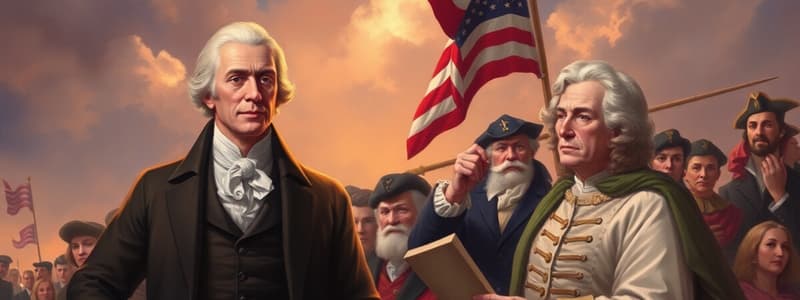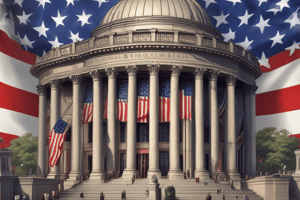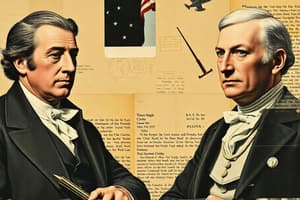Podcast
Questions and Answers
What was one of the key disagreements between the Federalists and the Democratic-Republicans in regards to government power?
What was one of the key disagreements between the Federalists and the Democratic-Republicans in regards to government power?
- The Federalists believed in a stronger national government with a broad interpretation of the necessary and proper clause, while the Democratic-Republicans favored a weaker national government with a strict interpretation. (correct)
- The Federalists believed in a powerful military with a large standing army, while the Democratic-Republicans favored a smaller, less powerful military.
- The Federalists believed in a centralized banking system, while the Democratic-Republicans opposed a centralized banking system.
- The Federalists believed in a weaker national government with a strict interpretation of the necessary and proper clause, while the Democratic-Republicans favored a stronger national government with a broad interpretation.
What was one of the main factors contributing to the formation of the first two American political parties?
What was one of the main factors contributing to the formation of the first two American political parties?
- Disagreements over the location of the national capital.
- Conflicts related to land ownership and westward expansion.
- Disputes over the interpretation of the Constitution, particularly regarding the necessary and proper clause. (correct)
- Different views on trade and economic policies.
What was the significance of the Judiciary Act of 1789?
What was the significance of the Judiciary Act of 1789?
- It created a system of federal courts, including district courts, circuit courts, and the Supreme Court. (correct)
- It defined the powers and responsibilities of the executive branch of the government.
- It established the Federal Reserve System, overseeing the nation's central bank.
- It outlined the procedures for amending the Constitution.
Which of the following individuals served as the first Chief Justice of the United States?
Which of the following individuals served as the first Chief Justice of the United States?
How did the Federalists and Democratic-Republicans differ in their views on the French Revolution?
How did the Federalists and Democratic-Republicans differ in their views on the French Revolution?
What was President Washington's stance on the relationship between the United States and France during the French Revolution?
What was President Washington's stance on the relationship between the United States and France during the French Revolution?
How did George Washington set precedents for future presidents?
How did George Washington set precedents for future presidents?
What was the name of the treaty that formalized the alliance between the United States and France during the American Revolutionary War?
What was the name of the treaty that formalized the alliance between the United States and France during the American Revolutionary War?
Which of the following was NOT a component of Hamilton's economic plan?
Which of the following was NOT a component of Hamilton's economic plan?
How did the Democratic-Republicans react to Hamilton's plan?
How did the Democratic-Republicans react to Hamilton's plan?
What was the main reason for the Whiskey Rebellion?
What was the main reason for the Whiskey Rebellion?
What was the main effect of the Whiskey Rebellion on the United States?
What was the main effect of the Whiskey Rebellion on the United States?
What precedent was set by George Washington's decision not to run for a third term as president?
What precedent was set by George Washington's decision not to run for a third term as president?
Which of the following statements accurately reflects the primary purpose of Hamilton's financial plan?
Which of the following statements accurately reflects the primary purpose of Hamilton's financial plan?
How did Hamilton's economic plan intend to protect domestic industry?
How did Hamilton's economic plan intend to protect domestic industry?
Which of the following was NOT a concern of the Democratic-Republicans regarding Hamilton's financial plan?
Which of the following was NOT a concern of the Democratic-Republicans regarding Hamilton's financial plan?
Flashcards
US Neutrality Declaration 1793
US Neutrality Declaration 1793
A statement issued to maintain the US's stance of not taking sides in foreign conflicts.
Hamilton's Economic Plan
Hamilton's Economic Plan
A strategy to pay off national debt and strengthen federal government using state debts, bonds, taxes, and tariffs.
Bonds
Bonds
Debt securities issued to raise revenue for the government.
Excise Taxes
Excise Taxes
Signup and view all the flashcards
Tariffs
Tariffs
Signup and view all the flashcards
National Bank Purpose
National Bank Purpose
Signup and view all the flashcards
Whiskey Rebellion
Whiskey Rebellion
Signup and view all the flashcards
Washington's Farewell Address
Washington's Farewell Address
Signup and view all the flashcards
George Washington's Presidency
George Washington's Presidency
Signup and view all the flashcards
Judiciary Act of 1789
Judiciary Act of 1789
Signup and view all the flashcards
First Chief Justice
First Chief Justice
Signup and view all the flashcards
President's Cabinet
President's Cabinet
Signup and view all the flashcards
Federalists
Federalists
Signup and view all the flashcards
Democratic-Republicans
Democratic-Republicans
Signup and view all the flashcards
Loose vs. Strict Interpretation
Loose vs. Strict Interpretation
Signup and view all the flashcards
US Neutrality Policy
US Neutrality Policy
Signup and view all the flashcards
Study Notes
The New Nation: Washington's Presidency
- 1788: George Washington was unanimously elected the first President of the United States.
- He set many precedents, which are examples followed by later leaders.
- The Constitution established the Supreme Court, but left lower courts to Congress.
- The Judiciary Act of 1789 created the federal court system with: thirteen district courts, three circuit courts, and one Supreme Court.
- Washington created the President's cabinet with advisors, including: Department of State (Thomas Jefferson), Treasury (Alexander Hamilton), War (Henry Knox) and Attorney General (Edmund Randolph).
- During Washington's presidency, America's first two political parties formed: the Federalists and the Democratic-Republicans.
- Federalists: Led by Alexander Hamilton and John Adams, representing Northern merchants, and favoured a strong national government.
- Democratic-Republicans: Led by Thomas Jefferson and James Madison, representing Southerners and farmers, and advocated for state's rights and individual liberties.
- Disputes arose over the interpretation of the "necessary and proper" clause in the Constitution. Federalists favoured a looser interpretation, while Democratic-Republicans favoured a stricter interpretation.
- Initially, Americans supported the French Revolution, as the French had aided the Americans during the Revolutionary War.
- However, a division emerged during the Reign of Terror, the rise of Napoleon, and his European wars.
- The Federalists opposed supporting France, while the Democratic-Republicans supported the French. Washington declared US neutrality in 1793.
- Hamilton's financial plan aimed to pay off national and state debts using bonds, excise taxes (taxes on goods), and tariffs (taxes on imports). This was controversial as it mainly benefited the wealthy.
- The plan also included establishing a national bank to strengthen the national government and regulate state banks.
- The Democratic-Republicans opposed Hamilton's plan, fearing a powerful national government.
- A compromise was reached, where the South agreed to federal assumption of debt in exchange for the national capital being moved to the South (Washington D.C.).
- The whiskey tax, part of Hamilton's plan, angered Pennsylvania farmers leading to the Whiskey Rebellion in 1794.
- Washington personally led troops, swiftly suppressing the rebellion which demonstrated the strength of the new federal government.
- As president, Washington served two terms (eight years). He established a precedent by not seeking a third term.
- He issued his Farewell Address, which advised the nation to avoid political factions and foreign entanglements.
Studying That Suits You
Use AI to generate personalized quizzes and flashcards to suit your learning preferences.




